Introduction:
Software development methodologies are approaches or frameworks that provide guidance and structure to the process of developing software. These methodologies help teams organize their work, collaborate,effectively, and deliver high-quality software. There are various software development methodologies, each with its own principles, practices, and advantages. Here are some of the commonly used methodologies:
In the article, I will delve into the topic of software development methodologies and explain how we at uptech choose which software methodology works best for our client project.
Waterfall Model:
The Waterfall Model is one of the traditional and linear approaches to software development. It follows a sequential, phased, and non-iterative process, where progress is seen as flowing steadily downwards (like a waterfall) through several distinct phases. Each phase in the Waterfall Model must be completed before moving on to the next one, and changes are challenging to incorporate once a phase is finished.
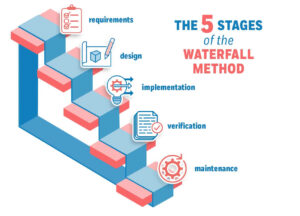
- Sequential Approach: This model follows a linear and sequential approach, where each phase must be completed before moving on to the next.
- Documentation Intensive: It emphasizes thorough documentation at each stage of development.
- Limited Flexibility: Changes are difficult to incorporate once a phase is completed.
Agile Methodology:
- Iterative and flexible approach.
- Emphasizes collaboration, customer feedback, and small, rapid releases.
- Adaptive to changing requirements through regular reassessment.The specific methodology or framework adopted often depends on the project’s characteristics, team preferences, and organizational context.

Scrum:
Scrum is an Agile framework designed to facilitate the development of complex software projects. It emphasizes flexibility, collaboration, and customer feedback throughout the development process. Scrum is widely used in various industries beyond software development, including product development, marketing, and research.
Roles:
Scrum Master: Facilitates the Scrum process, ensures that the team follows Scrum principles, and helps remove obstacles.
Product Owner: Represents the customer and defines the features and priorities of the product.
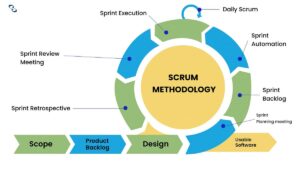
Artifacts:
Product Backlog: An ordered list of all features, enhancements, and bug fixes that constitute the project’s requirements. Maintained by the Product Owner.
Increment: The sum of all the completed Product Backlog items at the end of a sprint.
Kanban:
- Lean methodology focusing on continuous delivery.
- Visualizes the workflow on a Kanban board.
- Limits work in progress to optimize efficiency and responsiveness.
Extreme Programming (XP):
Extreme Programming (XP) is an Agile software development methodology that aims to improve software quality and responsiveness to changing customer requirements through frequent releases and iterations. XP emphasizes customer satisfaction, teamwork, and technical excellence. It was introduced by Kent Beck in the late 1990s and has since gained popularity for its focus on practices that enhance code quality and collaboration.
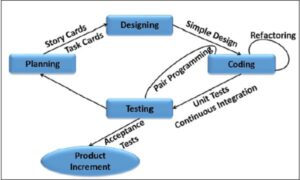
User Stories:
- Requirements are expressed as user stories, short descriptions of desired functionality from an end-user perspective.
Pair Programming: Developers work in pairs, with one writing code (the “driver”) and the other reviewing the code and providing feedback. Encourages knowledge sharing, improves code quality, and helps catch errors early.
Test-Driven Development (TDD): Developers write automated tests before writing the actual code. Code is then written to pass the tests, ensuring that the code meets the specified requirements and is testable.
Continuous Integration:
- Code changes are integrated frequently, and automated builds and tests are run to detect integration issues early.
- Ensures that the code base is always in a working state.
Collective Code Ownership:
- All team members are responsible for the code base, and anyone can make changes to any part of the code.
- Encourages collaboration and avoids bottlenecks.
Continuous Feedback: Regular feedback is sought from customers, team members, and automated tests to identify and address issues promptly.
Incremental Model: Evolutionary approach where the system is built, expanded, and improved upon in increments. Each increment adds to the existing functionality.
Feature-Driven Development (FDD):
Feature-Driven Development (FDD) is an iterative and incremental software development methodology that focuses on building features in a planned and systematic way. It was introduced by Jeff De Luca and Peter Coad in the mid-1990s. FDD is particularly suitable for larger projects and is based on five key principles: FDD can be particularly effective when there is a need to scale development efforts and manage a large number of features.
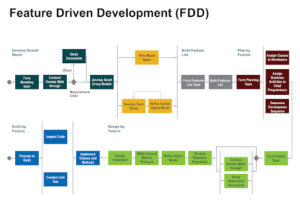
Domain Object Modeling: FDD places a strong emphasis on understanding the domain of the problem being solved. The development team creates a comprehensive model of the problem domain, identifying key business entities and their relationships.
Feature list: FDD builds a feature list based on the domain model. Features represent tangible, client-valued functions or services provided by the system.
Feature Teams: The development process is organized around feature teams. Each feature team is responsible for implementing a specific set of features and is typically composed of 5-8 developers.
Chief Programmer: This individual oversees the overall design and is responsible for ensuring that the feature teams are following the established design and coding standards. The role of a Chief Programmer, or Chief Architect, is crucial in FDD.
Feature-Driven Development Process: The FDD process involves developing an overall model, building a feature list, planning, designing, building features, and conducting inspections.
Feature-Driven Development is well-suited for large, complex projects where a clear understanding of the domain is crucial. It provides a structured approach to development, emphasizing collaboration, accountability, and the incremental delivery of features.
Rapid Application Development (RAD):
Rapid Application Development (RAD) is a software development methodology that prioritizes quick development and iteration of prototypes over extensive planning and testing. The focus is on delivering a functional product rapidly, often through iterative development and the use of feedback from end-users. RAD is particularly well-suited for projects where requirements are expected to change frequently and where user involvement is critical.
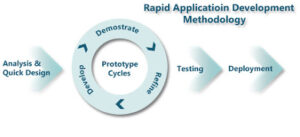
Iterative Development:
- Each iteration results in a partial but functional system, and subsequent iterations build upon the previous ones.
- RAD involves a series of iterations or prototyping cycles.
User Involvement:
- End-users are actively involved throughout the development process.
- User feedback is gathered and incorporated into subsequent iterations, ensuring that the final product aligns closely with user needs.
Collaborative Development:
- RAD emphasizes collaborative and interactive development.
- Developers, users, and other stakeholders work closely together to refine requirements, design, and test the software.
Reusable Components:
- RAD encourages the use of existing software components and the creation of reusable code.
- This can accelerate development and reduce redundancy.
Minimal Planning:
- Unlike some traditional methodologies, RAD minimizes upfront planning and documentation.
- The focus is on delivering a functional product quickly, with planning and documentation evolving as the project progresses.
Continuous Integration:
- Continuous integration of components is a key aspect of RAD to ensure that the overall system remains cohesive and functional.
RAD is suitable for projects where time-to-market is crucial, requirements are likely to change, and there is a need for rapid prototyping and user feedback.
Spiral Model:
Choosing the right methodology depends on the project’s size, complexity, the team’s skill set, and the organization’s goals.
Conclusion:
In conclusion, software development methodologies play a pivotal role in shaping the efficiency and success of software projects. . Agile methodologies, such as Scrum and Kanban, prioritize flexibility and iterative development, fostering collaboration and adaptability. Waterfall methodologies offer a structured, linear approach, ensuring detailed planning and clear milestones. DEV Ops integrates development and operations, enhancing collaboration and accelerating delivery through automation. Choosing the right methodology depends on project requirements, team dynamics, and organizational goals. Ultimately, successful software development hinges on a well-chosen methodology that aligns with the project’s unique needs, promoting collaboration, efficiency, and timely delivery of high-quality software solutions.

